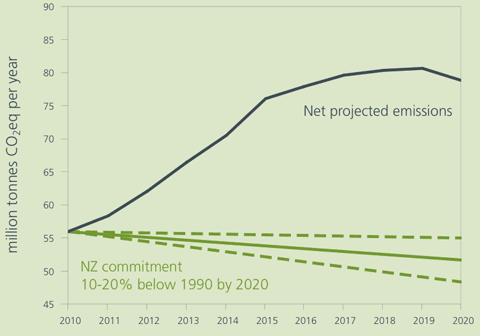 Australia will set a price on carbon from July next year, Aussie PM Julia Gillard announced yesterday. Cost per tonne will be set at A$23, rising 2.5% per annum, and the initial tax will morph into an emissions trading scheme from 2015. A full list of the key points and links to comment and reaction below the fold (as they used to say at the News Of The World)…
Australia will set a price on carbon from July next year, Aussie PM Julia Gillard announced yesterday. Cost per tonne will be set at A$23, rising 2.5% per annum, and the initial tax will morph into an emissions trading scheme from 2015. A full list of the key points and links to comment and reaction below the fold (as they used to say at the News Of The World)…
Tag: ETS
The billion dollar gap
 Dr Jan Wright, New Zealand’s parliamentary commissioner for the environment, today released her submission (pdf) to the Emissions Trading Review panel. It calls for a significant toughening up of the scheme that was so extensively watered down by the current government in 2009, in order to avoid a billion dollar per year cost to taxpayers. Wright’s recommendations make it clear that any further weakening of the scheme as the result of pleading by special interests can not be justified. She recommends that:
Dr Jan Wright, New Zealand’s parliamentary commissioner for the environment, today released her submission (pdf) to the Emissions Trading Review panel. It calls for a significant toughening up of the scheme that was so extensively watered down by the current government in 2009, in order to avoid a billion dollar per year cost to taxpayers. Wright’s recommendations make it clear that any further weakening of the scheme as the result of pleading by special interests can not be justified. She recommends that:
- both the price cap and the two-for-one deal expire on 31 December 2012 as currently legislated.
- a) a cap on the number of carbon credits freely allocated be put in place; and that
b) the phase-out rates for allocation be increased, not expressed as a percentage decrease of the previous year, and that the latest year in which allocation of free carbon credits must cease be specified.- the ETS is amended:
a) so that new industries that use lignite on a large scale are specifically excluded from receiving any free carbon credits;
b) to provide criteria for deciding which new activities are eligible to receive free carbon credits, including a requirement that the new activity will reduce New Zealand’s national net greenhouse gas emissions.- agriculture is brought into the ETS by 2015 as currently legislated.
The submission contains a picture worth at least a thousand words: this graph makes it very clear why the NZ ETS needs toughening up:

Current policy settings effectively guarantee that the government’s Copenhagen Accord commitment to a 10% cut in emissions by 2020 is nothing but an empty promise. The ETS is not delivering the goods — and it will be the taxpayers that pay the cost. Wright estimates that the “gap” between target and projected emissions “is likely to cost New Zealand over a billion dollars per year” by 2020.
Lignite: dirty brown forbidden fruit
 Two items during this week highlighted the continuing progress of Solid Energy’s intentions to develop the Southland lignite fields. I therefore provide this depressing update to two Hot Topic posts on the issue late last year. Don Elder (left), CEO of state-owned enterprise Solid Energy, appeared before the Commerce select committee during the week and announced that the proposed lignite developments will be worth billions. And it appears that this will be the case even if they don’t receive free carbon credits under the ETS, which they appear to nevertheless hope for. There was a slight acknowledgement that there were carbon footprint issues still to be resolved and some soothing suggestions, reported in the Otago Daily Times, that approaches such as mixing synthetic diesel with biofuels, carbon capture and storage, and planting trees, could reduce the net emissions. With a convenient fall-back – that the company could pay someone elsewhere in the world to do this for it. There is little evidence that carbon capture and storage will feature as anything more than talk in this scenario. The wildest extremity of the CCS option was touched on outside the committee when Elder spoke of the possibility of eventually piping carbon out to sea and pumping it into sea-floor oil or gas wells, after the Great South Basin has been developed.
Two items during this week highlighted the continuing progress of Solid Energy’s intentions to develop the Southland lignite fields. I therefore provide this depressing update to two Hot Topic posts on the issue late last year. Don Elder (left), CEO of state-owned enterprise Solid Energy, appeared before the Commerce select committee during the week and announced that the proposed lignite developments will be worth billions. And it appears that this will be the case even if they don’t receive free carbon credits under the ETS, which they appear to nevertheless hope for. There was a slight acknowledgement that there were carbon footprint issues still to be resolved and some soothing suggestions, reported in the Otago Daily Times, that approaches such as mixing synthetic diesel with biofuels, carbon capture and storage, and planting trees, could reduce the net emissions. With a convenient fall-back – that the company could pay someone elsewhere in the world to do this for it. There is little evidence that carbon capture and storage will feature as anything more than talk in this scenario. The wildest extremity of the CCS option was touched on outside the committee when Elder spoke of the possibility of eventually piping carbon out to sea and pumping it into sea-floor oil or gas wells, after the Great South Basin has been developed.
The odds are much worse than 50-50
 Nick Smith, NZ’s climate change minister, told the Bluegreens forum in Akaroa last weekend that the government was considering gazetting their “50 by 50” target for carbon emissions — a 50 percent cut in emissions by 2050. That target has been National Party policy since before the last election, so the only real news is that the government is considering making it “official”, in the terms of the Climate Change Response Act 2002. Smith continues to represent this target as challenging (which is true), and in line with other countries commitments (which is less so), but where it really falls down is by being completely out of line with what is actually required if we are to avoid the worst effects of climate change in the future.
Nick Smith, NZ’s climate change minister, told the Bluegreens forum in Akaroa last weekend that the government was considering gazetting their “50 by 50” target for carbon emissions — a 50 percent cut in emissions by 2050. That target has been National Party policy since before the last election, so the only real news is that the government is considering making it “official”, in the terms of the Climate Change Response Act 2002. Smith continues to represent this target as challenging (which is true), and in line with other countries commitments (which is less so), but where it really falls down is by being completely out of line with what is actually required if we are to avoid the worst effects of climate change in the future.
The last time the government considered emissions targets was in the run up to the Copenhagen conference in 2009. At the time, I posted an analysis of global and national emissions targets — The First Cut Is The Deepest. It still remains valid today, made more piquant by the sense of impending changes of climate and the notable extreme weather events that have accumulated since. Here’s my simplified cheat sheet…
Can you dig it?

On the same day that I wrote a post about the proposed lignite development in Southland I emailed the Minister for Economic Development, Gerry Brownlee, to express my dismay at the news. I have received a letter in reply which explains all too clearly how such a development could, and presumably will, proceed under current policy.
In my email to the Minister I pointed out that simply offsetting the massive emissions from lignite development would hardly be in line with the intention of the Emissions Trading Scheme (ETS) and the imperative to reduce greenhouse gas emissions. I wrote that unless there are clear plans to capture and sequester the carbon dioxide which will be released the company should not be permitted to undertake any of the proposals. The government is the owner of Solid Energy, able to tell the company it is not to proceed with the plans, and if necessary able to legislate to prevent the development of lignite until such time as sequestration technology is established. I spoke of the Minister’s duty to prevent such development at this time, and stated in conclusion that his obligation to protect our descendants from the potentially terrifying effects of climate change far outweighs any responsibility he carries for present economic development.
The Minister’s reply first assured me that, like me, the Government is concerned about climate change and is committed to doing its “fair share” in reducing New Zealand’s greenhouse gas emissions. The fair share theme is a constant in government statements about climate change these days. It’s a politically useful term: it reminds those who want to do considerably less than we are doing that we can’t afford to appear laggard, and it also serves to placate those who feel we are less than whole-hearted in tackling the issue. It’s hard to argue with, and I can understand its attraction for the government. Nevertheless it’s hardly the kind of term that immediately leaps to mind if one really is concerned about climate change. It suggests that the Government worry is not so much climate change as political positioning.
The Minister goes on to say the ETS is the Government’s principal policy response to climate change. It puts a price on greenhouse gases, he explains, and provides an incentive to reduce emissions and to encourage tree planting. He then adds that it does not provide a cap for existing (or future) emissions and hence is not prescriptive about what developments should or should not progress. This strikes me as a very clear admission that the ETS may not, in fact, result in any reduction of emissions at all. It is a remarkable act of faith in the power of incentives, and an abdication of responsibility for the outcome.
That abdication becomes clearer as the letter proceeds. It is admitted that lignite developments of the scale being investigated by Solid Energy will create significant greenhouse gas emissions, depending on the particular projects chosen. However any development will be “carbon compliant” with New Zealand’s greenhouse gas emission management frameworks. That looks like meaning that Solid Energy will pay whatever is required under the ETS to cover the cost of its emissions, and if the project remains profitable under such a regime it will go ahead whatever the level of its emissions.
But if Geoff Bertram and Simon Terry have it right in their book The Carbon Challenge, Solid Energy, far from paying for the emissions from a plant to manufacture urea from lignite, may well be entitled to subsidies in the form of free emission units for its operations provided it meets certain benchmark standards for ‘emissions intensity’. Bertram and Terry estimate that subsidy could go as high as between $500 million and $1 billion dollars in nominal terms over the first twenty years of the plant’s life. This, even though it would be the country’s biggest single industrial emitter of greenhouse gases after the Huntly power station.
Back to the Minister’s letter. A paragraph follows noting that to potentially mitigate against CO2 emissions Solid Energy is actively following the progress of Carbon Capture and Storage (CCS). The letter referred me to a page on the Ministry of Economic Development website for information about government-industry collaboration on the active investigation of the feasibility of CCS in New Zealand. Maybe I missed something but the page looked pretty sleepy to me. There’s little sign there that CCS is likely to figure prominently in Solid Energy’s lignite projects.
The Minister’s letter then emphasises that projects of this scale have long lead times. He is aware of investigative drilling and pre-feasibility studies, but as yet the decision to commence project construction has not been made. As no formal proposal has been lodged he cannot pre-empt outcomes. I don’t know what pre-empting means in this context, but it seems pretty clear from the rest of the letter that he won’t be looking to create any obstacles.
A final paragraph points out that a development of this scale “that can effectively manage its emissions profile” would provide significant opportunities for New Zealand, maybe even bringing about “a step change” in New Zealand’s growth. Given that the bar for the management of emissions is set so low what this seems to mean is that we’re soon to enjoy major economic benefit from the development of lignite. Am I being unfair in drawing the conclusion that this counts for the Minister ahead of any climate change concern?
The kindest thing one can say of the Minister and the Government he represents is that they have as yet no adequate conception of the magnitude of the threats that come with climate change. I’ll do them the courtesy of presuming that if they did they would have made it very clear by now that the lignite will stay in the ground.
